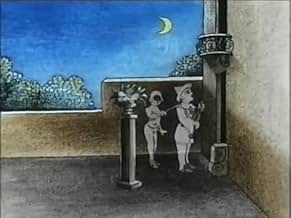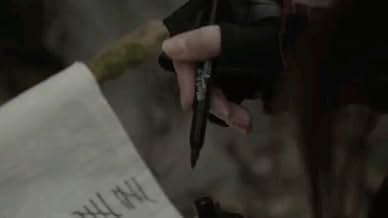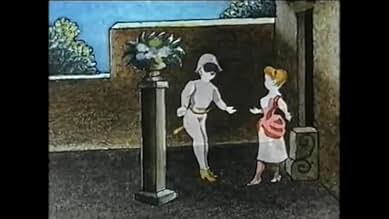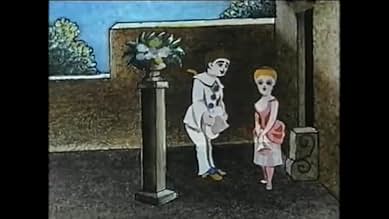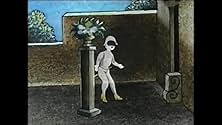IMDb-BEWERTUNG
6,5/10
2216
IHRE BEWERTUNG
Füge eine Handlung in deiner Sprache hinzuOne night, Arlequin come to see his lover Colombine. But then Pierrot knocks at the door and Colombine and Arlequin hide. Pierrot starts singing but Arlequin scares him and the poor man goes... Alles lesenOne night, Arlequin come to see his lover Colombine. But then Pierrot knocks at the door and Colombine and Arlequin hide. Pierrot starts singing but Arlequin scares him and the poor man goes away.One night, Arlequin come to see his lover Colombine. But then Pierrot knocks at the door and Colombine and Arlequin hide. Pierrot starts singing but Arlequin scares him and the poor man goes away.
- Regie
- Drehbuch
Empfohlene Bewertungen
Cute and strange; oh, and it's the first animated thing put to film... ever. Impressive for that alone, AND it has a story! It may not be too deep, and may be a little confusing (what's with the guy that comes out of nowhere and steals the guy's ukulele or whatever it is, is he a ghost?) But it does have a beginning, middle and sort of an end, maybe, arguably. For what this french animator was able to accomplish - and did I mention in COLOR no less - and for the simple fact that this is one of the major accomplishments of that century, to get something with images moving, albeit jerkily, I say you should check out all four minutes on YouTube or wherever silent film shorts are sold.
History lesson time! Back when films were viewed as magical gimmicks rather than an art form, inventor Reynaud made advancements on the standard zoetrope that children would be hypnotised by, and patented the praxinoscope. The difference? The ability to give further dimensions to the strips that are used to project a flowing film. And that's where Pauvre Pierrot comes in (roughly translated as "Poor Pete"), part one of three short stories that combined to produce Reynaud's 'Pantomimes Lumineuses'. Whilst the other two are considered lost, this third has had four minutes restored from its original fifteen minute runtime. And much to my surprise, it's just as viewable now as it was back in 1892.
The straightforward plot consists of a man teasing another man to scare him away from a woman he was trying to woo. The limited fluidity resulted in the story being as clunky as various frame transitions (occasionally pausing on every third strip), but for such an experimental ancient silent film, the story isn't exactly at the forefront. It's the innovation, and Reynaud was an innovator through and through. Just by staring at the detailed drawings that are able to exude featured facial expressions, you get a sense of commitment from Reynaud. The lack of narrative interest is seemingly masked by the grandeur of this static backdrop, and it's still stupendously amazing to watch today. Will I remember it next week? Most likely not. However it's imperative to appreciate the milestones that paved the way for films today, and Pauvre Pierrot is a technical achievement.
The straightforward plot consists of a man teasing another man to scare him away from a woman he was trying to woo. The limited fluidity resulted in the story being as clunky as various frame transitions (occasionally pausing on every third strip), but for such an experimental ancient silent film, the story isn't exactly at the forefront. It's the innovation, and Reynaud was an innovator through and through. Just by staring at the detailed drawings that are able to exude featured facial expressions, you get a sense of commitment from Reynaud. The lack of narrative interest is seemingly masked by the grandeur of this static backdrop, and it's still stupendously amazing to watch today. Will I remember it next week? Most likely not. However it's imperative to appreciate the milestones that paved the way for films today, and Pauvre Pierrot is a technical achievement.
Pauvre Pierrot, directed by Charles-Émile Reynaud, is one of the first animated films ever made. It is made up of 500 individually painted images and originally lasted about 15 minutes. The version available to today is a 4 minute version, restored from pieces of the original.
It's a simple story of a woman with two men wooing her, one she cares for, and the other which is somewhat a nuisance to her, even if he is sincere. To achieve his effects, Reynaud invented his Théâtre-Optique system which was basically a zoetrope with a projector. The images showed successive images of moving figures in front of blackbackgrounds. These images could be adjusted in real-time to project tthe animated characters against an immobile background image which was being projected by a second projector from a painted glass plate.
At times the show was quite elaborate. Original music and songs were written for the show, played by an piano accompanyist and sung by an actor. Reynaud performed 12,800 shows from 1892 to 1900. Commercially successful for a time, the popularity of these shows were eventually overtaken by the projected camera live action films of the Lumières and others.
It's a simple story of a woman with two men wooing her, one she cares for, and the other which is somewhat a nuisance to her, even if he is sincere. To achieve his effects, Reynaud invented his Théâtre-Optique system which was basically a zoetrope with a projector. The images showed successive images of moving figures in front of blackbackgrounds. These images could be adjusted in real-time to project tthe animated characters against an immobile background image which was being projected by a second projector from a painted glass plate.
At times the show was quite elaborate. Original music and songs were written for the show, played by an piano accompanyist and sung by an actor. Reynaud performed 12,800 shows from 1892 to 1900. Commercially successful for a time, the popularity of these shows were eventually overtaken by the projected camera live action films of the Lumières and others.
It's cheating a little to list this as a film as strictly speaking it's not one, though its maker Émile Reynaud pushed pre-cinema technology as far as it could go to achieve an experience practically indistinguishable from that of watching a theatrical presentation of an animated cartoon film. His Théâtre Optique featured his Praxinoscope, a radical development of old-established animation toys like the Zoetrope. This used rotating faceted mirrors and lenses that could project a succession of hand-drawn images from a paper strip with sprocket holes, allowing much longer sequences of continuous action than the short loops hitherto used in such devices. These images were then superimposed on a static background projected from a conventional magic lantern slide, prefiguring later cel animation techniques in which the image is broken down into a succession of layers with the minimum of movement in each one. The exhibition was completed with live narration and music.
Some of Reynaud's original elements survive (others he later threw in the Seine) and their affinity with film is demonstrated by the ease with which they can be reconstructed on modern film or video. Pauvre Pierrot was the first such production and is among the most charming, a simple tale featuring the traditional characters Pierrot, Arlequin and Colombine acting out their ancient love triangle. Some reconstructions replicate the translucent, slightly ghostly quality the characters would have had at the time. Sadly Reynaud's work was overtaken by the arrival of the cinema proper and he died a poor and unhappy man.
Some of Reynaud's original elements survive (others he later threw in the Seine) and their affinity with film is demonstrated by the ease with which they can be reconstructed on modern film or video. Pauvre Pierrot was the first such production and is among the most charming, a simple tale featuring the traditional characters Pierrot, Arlequin and Colombine acting out their ancient love triangle. Some reconstructions replicate the translucent, slightly ghostly quality the characters would have had at the time. Sadly Reynaud's work was overtaken by the arrival of the cinema proper and he died a poor and unhappy man.
J. Stuart Blackton's 'Humorous Phases of Funny Faces (1906)' is generally held as the first animated film. Indeed, it was the first animated film made on motion-picture film, but such history is nevertheless unfair to Émile Reynaud, who, fourteen years earlier, was projecting moving animated images to delighted audiences. 'Pauvre Pierrot (1892)' is one of the director's few surviving works (most were, in a fit of frustration, discarded into the Seine by the director himself), and such a colourful and charming curio remains a delight to behold.
Reynaud animated each frame himself – 500 in total (36 metres long) – and extended the film to 12-15 minutes by personally manipulating the picture-bands during the projection. The story told is a simple one: Pierrot and Arlequin compete for the romantic attention of Colombine, a beautiful maiden. One potential suitor attempts to charm the good lady with a lute performance, but his competitor goes one better with a baton or sword of some sort.
Reynaud's moving picture show, billed as "Théâtre Optique" or "Pantomimes Lumineuses," included a triple-bill of three films: 'Pauvre Pierrot,' 'Un bon bock (1892),' and 'Le Clown et ses chiens (1892).' One contemporary newspaper reported that Reynaud "creates characters with expressions and movements so perfect that they give the complete illusion of life." The show was initially a great success, but, in 1918, Reynaud died a poor man. His delicate work, prone to rapid degradation, could not compete with the Lumière brothers' cinematograph, which depicted real-life, and not merely an animated approximation.
Reynaud animated each frame himself – 500 in total (36 metres long) – and extended the film to 12-15 minutes by personally manipulating the picture-bands during the projection. The story told is a simple one: Pierrot and Arlequin compete for the romantic attention of Colombine, a beautiful maiden. One potential suitor attempts to charm the good lady with a lute performance, but his competitor goes one better with a baton or sword of some sort.
Reynaud's moving picture show, billed as "Théâtre Optique" or "Pantomimes Lumineuses," included a triple-bill of three films: 'Pauvre Pierrot,' 'Un bon bock (1892),' and 'Le Clown et ses chiens (1892).' One contemporary newspaper reported that Reynaud "creates characters with expressions and movements so perfect that they give the complete illusion of life." The show was initially a great success, but, in 1918, Reynaud died a poor man. His delicate work, prone to rapid degradation, could not compete with the Lumière brothers' cinematograph, which depicted real-life, and not merely an animated approximation.
Wusstest du schon
- WissenswertesThe cartoon was hand drawn on hundreds of sheets of glass, each inlaid in a leather strips, through which a light was shone projecting the figures on a backdrop, as it was spooled from one reel to another, much like a modern film reel.
- VerbindungenFeatured in La magie Méliès (2002)
Top-Auswahl
Melde dich zum Bewerten an und greife auf die Watchlist für personalisierte Empfehlungen zu.
Details
- Erscheinungsdatum
- Herkunftsland
- Sprache
- Auch bekannt als
- Armer Pierrot
- Weitere beteiligte Unternehmen bei IMDbPro anzeigen
- Laufzeit5 Minuten
- Sound-Mix
Zu dieser Seite beitragen
Bearbeitung vorschlagen oder fehlenden Inhalt hinzufügen

Oberste Lücke
By what name was Pauvre Pierrot (1892) officially released in Canada in English?
Antwort
